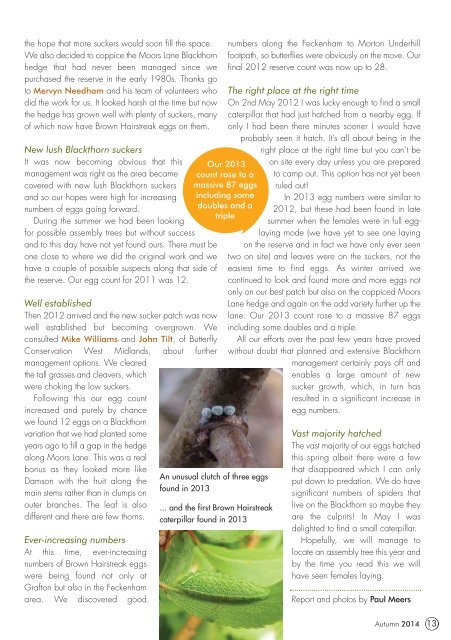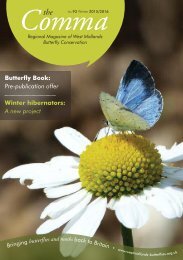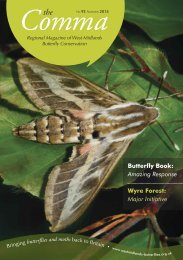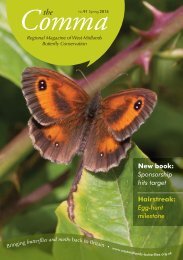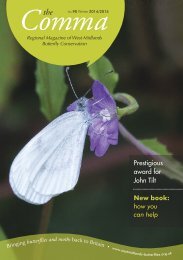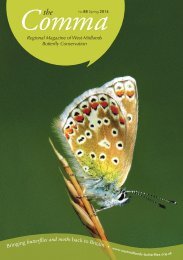Comma-WestMidBC-autumn-2014
Butterfly Magazine for the West Midlands Branch of Butterfly Conservation
Butterfly Magazine for the West Midlands Branch of Butterfly Conservation
Create successful ePaper yourself
Turn your PDF publications into a flip-book with our unique Google optimized e-Paper software.
the hope that more suckers would soon fill the space.<br />
We also decided to coppice the Moors Lane Blackthorn<br />
hedge that had never been managed since we<br />
purchased the reserve in the early 1980s. Thanks go<br />
to Mervyn Needham and his team of volunteers who<br />
did the work for us. It looked harsh at the time but now<br />
the hedge has grown well with plenty of suckers, many<br />
of which now have Brown Hairstreak eggs on them.<br />
New lush Blackthorn suckers<br />
It was now becoming obvious that this<br />
management was right as the area became<br />
covered with new lush Blackthorn suckers<br />
and so our hopes were high for increasing<br />
numbers of eggs going forward.<br />
During the summer we had been looking<br />
for possible assembly trees but without success<br />
and to this day have not yet found ours. There must be<br />
one close to where we did the original work and we<br />
have a couple of possible suspects along that side of<br />
the reserve. Our egg count for 2011 was 12.<br />
Well established<br />
Then 2012 arrived and the new sucker patch was now<br />
well established but becoming overgrown. We<br />
consulted Mike Williams and John Tilt, of Butterfly<br />
Conservation West Midlands, about further<br />
management options. We cleared<br />
the tall grasses and cleavers, which<br />
were choking the low suckers.<br />
Following this our egg count<br />
increased and purely by chance<br />
we found 12 eggs on a Blackthorn<br />
variation that we had planted some<br />
years ago to fill a gap in the hedge<br />
along Moors Lane. This was a real<br />
bonus as they looked more like<br />
Damson with the fruit along the<br />
found in 2013<br />
main stems rather than in clumps on<br />
outer branches. The leaf is also<br />
different and there are few thorns.<br />
Ever-increasing numbers<br />
At this time, ever-increasing<br />
numbers of Brown Hairstreak eggs<br />
were being found not only at<br />
Grafton but also in the Feckenham<br />
area. We discovered good<br />
Our 2013<br />
count rose to a<br />
massive 87 eggs<br />
including some<br />
doubles and a<br />
triple<br />
An unusual clutch of three eggs<br />
... and the first Brown Hairstreak<br />
caterpillar found in 2013<br />
numbers along the Feckenham to Morton Underhill<br />
footpath, so butterflies were obviously on the move. Our<br />
final 2012 reserve count was now up to 28.<br />
The right place at the right time<br />
On 2nd May 2012 I was lucky enough to find a small<br />
caterpillar that had just hatched from a nearby egg. If<br />
only I had been there minutes sooner I would have<br />
probably seen it hatch. It’s all about being in the<br />
right place at the right time but you can’t be<br />
on site every day unless you are prepared<br />
to camp out. This option has not yet been<br />
ruled out!<br />
In 2013 egg numbers were similar to<br />
2012, but these had been found in late<br />
summer when the females were in full egglaying<br />
mode (we have yet to see one laying<br />
on the reserve and in fact we have only ever seen<br />
two on site) and leaves were on the suckers, not the<br />
easiest time to find eggs. As winter arrived we<br />
continued to look and found more and more eggs not<br />
only on our best patch but also on the coppiced Moors<br />
Lane hedge and again on the odd variety further up the<br />
lane. Our 2013 count rose to a massive 87 eggs<br />
including some doubles and a triple.<br />
All our efforts over the past few years have proved<br />
without doubt that planned and extensive Blackthorn<br />
management certainly pays off and<br />
enables a large amount of new<br />
sucker growth, which, in turn has<br />
resulted in a significant increase in<br />
egg numbers.<br />
Vast majority hatched<br />
The vast majority of our eggs hatched<br />
this spring albeit there were a few<br />
that disappeared which I can only<br />
put down to predation. We do have<br />
significant numbers of spiders that<br />
live on the Blackthorn so maybe they<br />
are the culprits! In May I was<br />
delighted to find a small caterpillar.<br />
Hopefully, we will manage to<br />
locate an assembly tree this year and<br />
by the time you read this we will<br />
have seen females laying.<br />
Report and photos by Paul Meers<br />
Autumn <strong>2014</strong><br />
13


